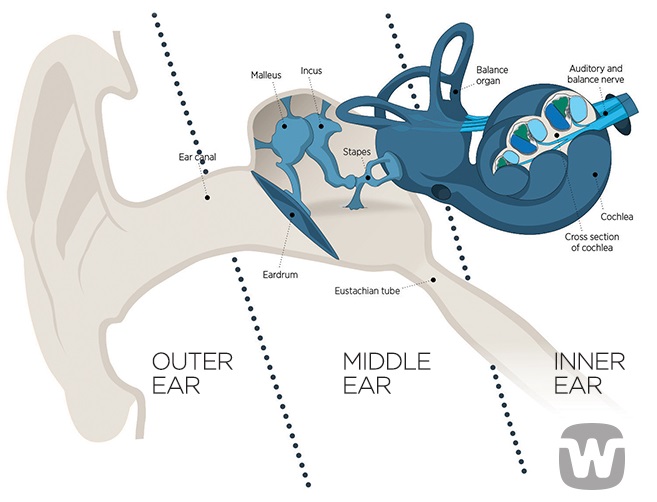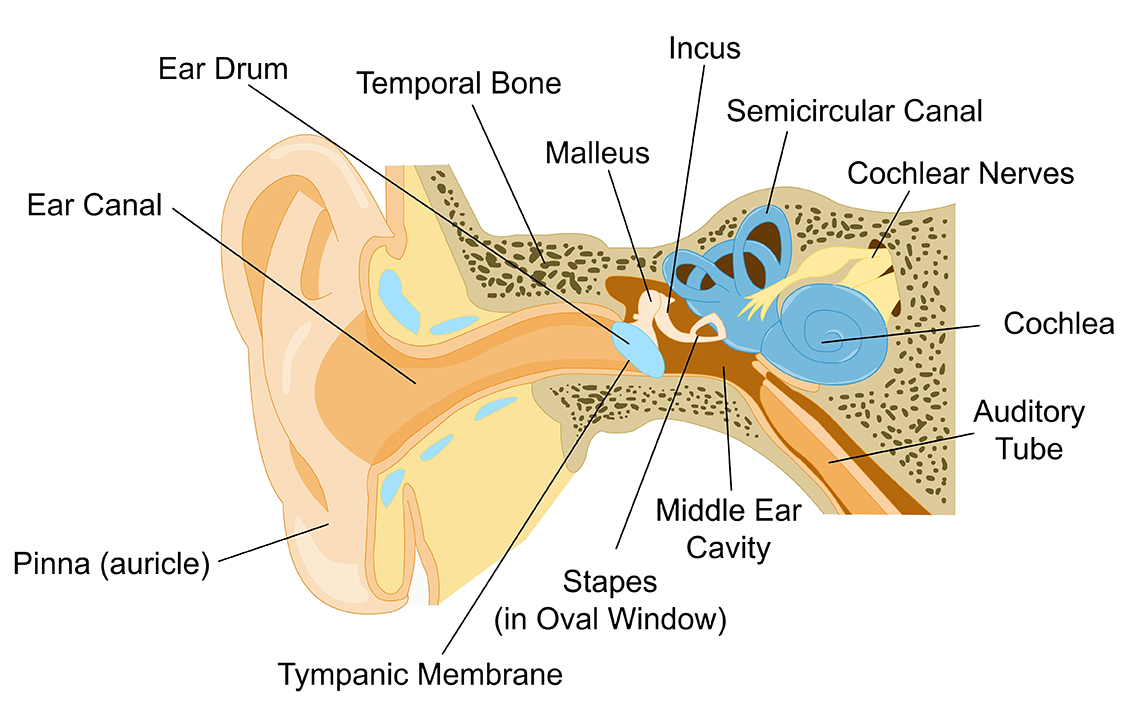The inner ear includes the hearing organ as well as the balance organ. The hearing organ is referred to as the cochlea. The cochlea is similar in shape to a snail shell. It is formed from a bony capsule that contains several fluid-filled membranous sections. The main three membranous compartments are: the vestibular canal, the medial canal, and the tympanic canal.
Along the medial canal there is an extremely sensitive sensory structure called the “organ of corti”. This structure has many different types of cells. However, two types of them are very critical to hearing: the outer hair cells and the inner hair cells. These cells contain hair-like structures at the top of each cell.
When the sound waves vibrate the oval window, the fluid inside the cochlea moves. This causes the hair-like structures to move. This motion activates the hair cells to transform the vibrations into electrical impulses that can travel via the auditory nerve and the central nervous system to the brain.

If the sensory cells inside the cochlea are damaged, they fail to transform the sound vibrations into electrical pulses and send it to the auditory nerve causing sensory hearing loss. A cochlear implant surgery is performed to place an implantable device that converts the sound energy to electrical pulses and bypasses the cochlea to the auditory nerve directly.
Cochlear implant technology is suitable for patients with severe to profound sensory hearing loss who couldn’t benefit from traditional hearing aids. A cochlear implant device is quite different from a hearing aid. Hearing aids amplify the sound and transmit it through the outer and middle ear to the sensory cells within the cochlea. However, if the sensory cells are damaged, the perception of
speech sound might still be compromised. A cochlear implant bypasses the damaged sensory cells of the inner ear and directly stimulates the auditory nerve that carries the signal to the brain to be interpreted.

The implant consists of an external portion that sits behind the ear and a second portion that is surgically placed under the skin (see figure). An implant has the following parts:
The external components:
- A microphone that picks up sound from the environment.
- A speech processor that selects and analyzes the sound picked up by the microphone.
- A transmitter that receives the signal from the speech processor and sends it wirelessly to the implanted device.
The internal components:
- An electrode array (i.e. a group of electrodes) that collects the impulses from the transmitter and sends them directly through the cochlea to different portions of the auditory nerve.
Any patient with severe to profound sensory hearing loss and didn’t benefit from traditional hearing aids is considered a candidate for cochlear implants regardless his age, unless medical contra-indications are present. However, the prognosis and medical outcomes of each individual might vary due to several factors, such as:
- Patient’s age.
- The language development of the patient.
- Duration of hearing loss.
- Amount of residual hearing.
- The general health of the patient.
- Proper diagnosis of hearing loss.
- The cochlear implant technology level.
- The success of the surgical procedure.
- The accuracy of programming and mapping of the cochlear implant device after the surgery
- The effectiveness of the aural rehabilitation, the speech therapy, and the follow up program.
- Many other factors.
The decision to receive a cochlear implant is based on the outcomes of comprehensive medical, audiological, and speech evaluations, and the decision is usually made by a team of:
- ENT physician: who evaluates the medical condition of the patient and identifies his candidacy for the surgery, and performs the cochlear implant surgery.
- Audiologist: who evaluates the audiological condition of the patient before and after the surgery, and performs the mapping of the device and conduct long term follow up of the patient.
- Speech language pathologist: who evaluates the language and speech abilities of the patient before the surgery, and conducts all the needed aural rehabilitation and speech therapy after the surgery.
- Other professionals might be consulted according to the patient’s situation such as: special educator, Psychologist, pediatrician, etc.
